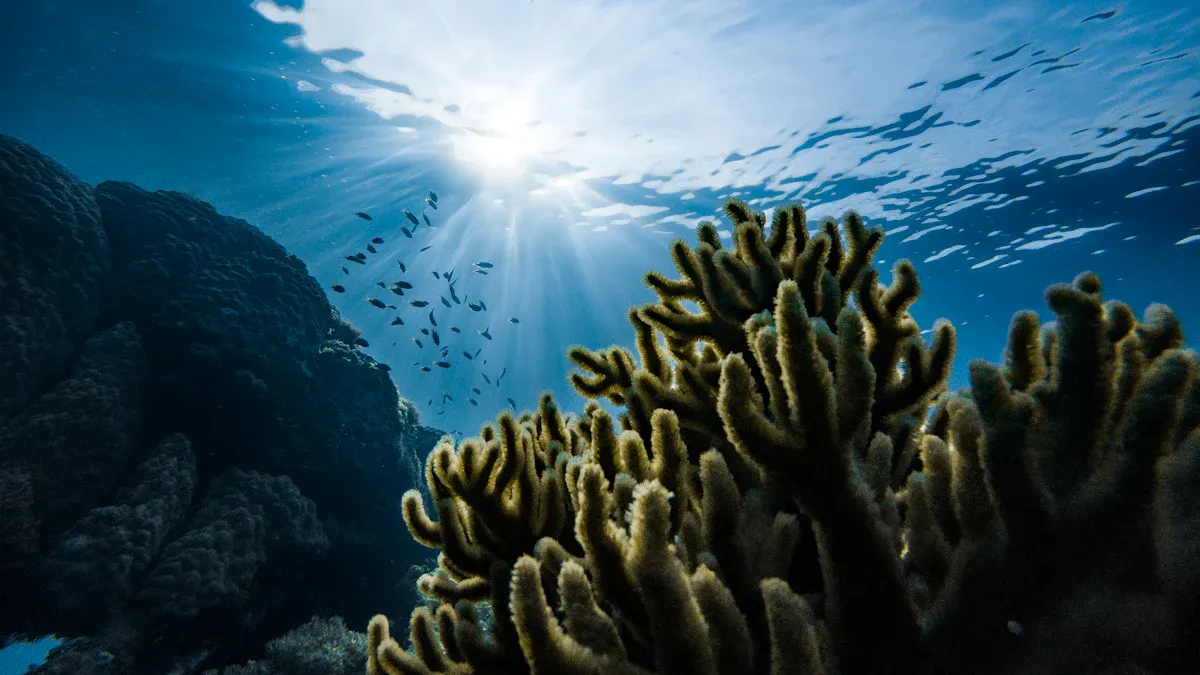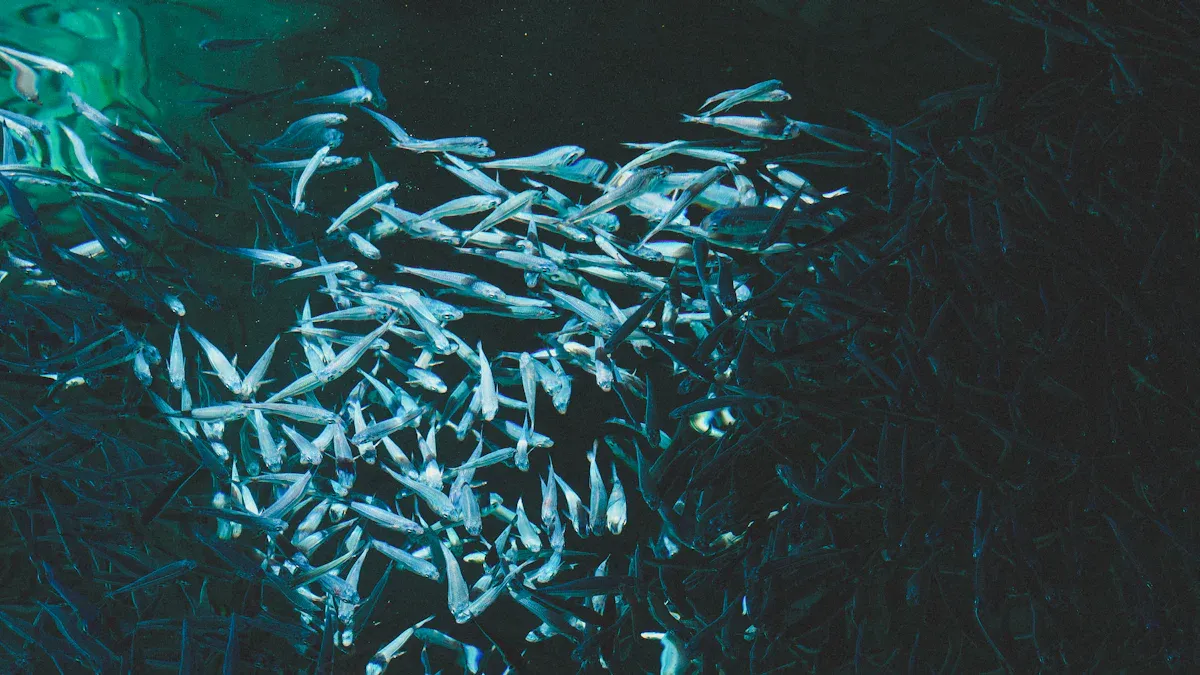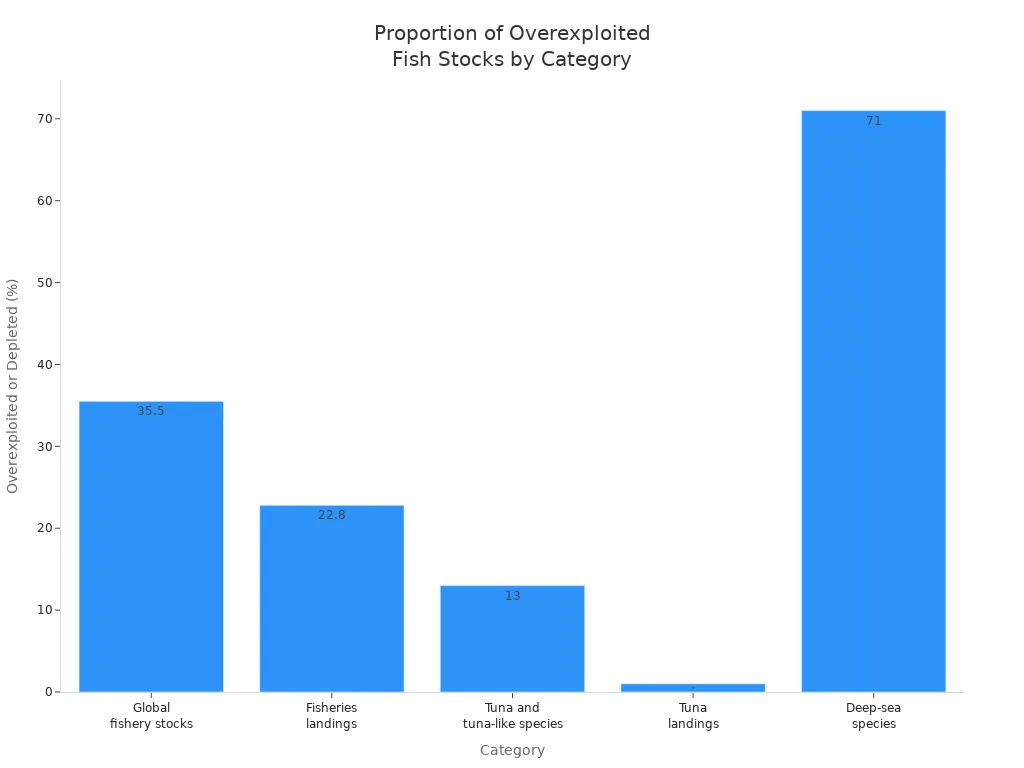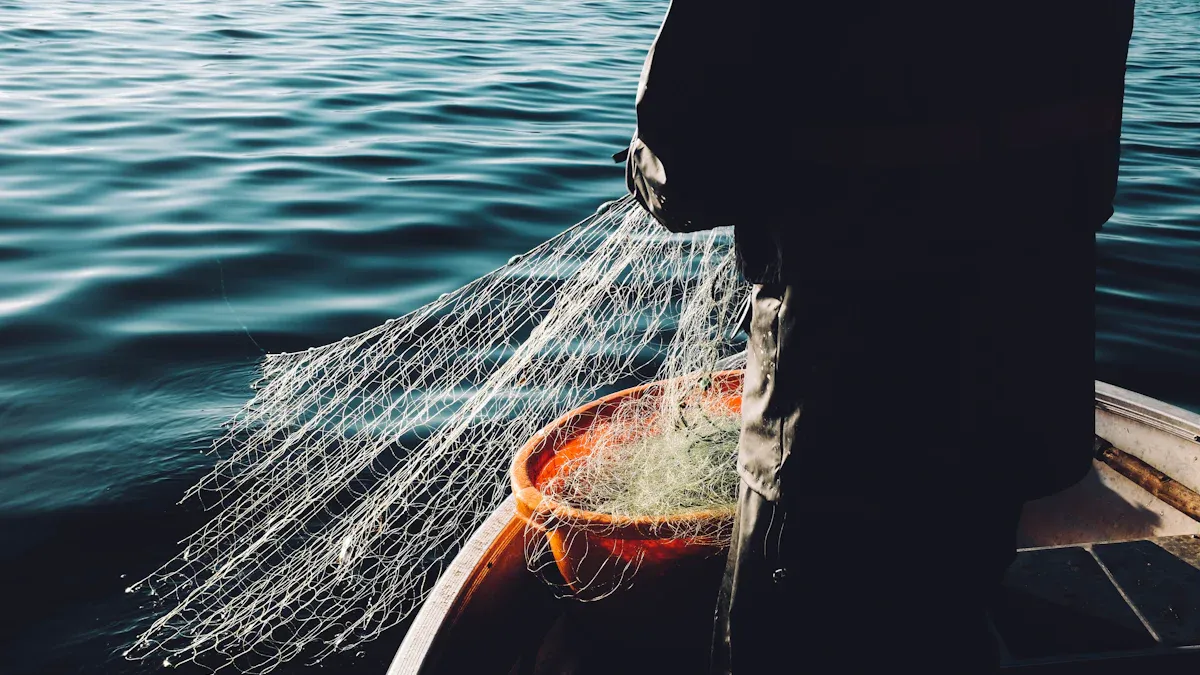
A Fish Meal Production System diverts about 25% of the global fish catch, nearly 20 million tons annually, from direct human consumption. This practice often targets food-grade fish. Over the past two decades, technological advances have improved efficiency, yet the pressure on marine ecosystems remains significant.
Key Takeaways
- Fish meal production heavily relies on catching small fish like anchovies and sardines, which harms marine food webs and threatens fish populations and the animals that depend on them.
- Bycatch and pollution from fish meal factories damage marine habitats and reduce biodiversity, making ecosystems less stable and more vulnerable to change.
- Overfishing driven by economic pressures harms local communities by reducing fish available for food and disrupting traditional fishing livelihoods, highlighting the need for better management and sustainable practices.
Overexploitation in Fish Meal Production Systems

Unsustainable Fishing and Stock Depletion
Unsustainable fishing practices remain a central challenge within the Fish Meal Production System. Each year, about 20% of the global wild fish catch is diverted to produce fish meal and fish oil, primarily for aquaculture feed. This heavy reliance on wild-caught fish, especially small pelagic species like anchovies and sardines, places immense pressure on marine resources. In regions such as West Africa, local fish stocks that support food security and artisanal fisheries are increasingly redirected toward fish meal production for export. This shift intensifies overexploitation and threatens the stability of local food systems.
The status of fish stocks used for fish meal varies by region and species. The table below summarizes recent global assessments:
| Category/Region/Species | Proportion Sustainable (%) | Proportion Overexploited or Depleted (%) |
|---|---|---|
| Global fishery stocks | 64.5 | 35.5 |
| Fisheries landings (production-weighted) | 77.2 | 22.8 |
| Tuna and tuna-like species | 87 | 13 |
| Tuna landings (production-weighted) | 99 | 1 |
| Deep-sea species | 29 | 71 |

Declining Populations of Forage Fish
Anchovies and sardines serve as the primary species targeted for fish meal production due to their abundance and high oil content. While these species can reproduce quickly, scientific studies reveal that fishing pressure amplifies natural population collapses. For example, a 2015 study found that intense fishing often precedes sharp declines in forage fish populations, making collapses more frequent and severe. Environmental factors cause natural fluctuations, but overfishing for reduction fisheries can push populations beyond recovery thresholds. Researchers recommend risk-based management to reduce fishing when stocks are low, helping to protect both forage fish and the predators that depend on them.
Overexploitation of forage fish not only threatens their populations but also disrupts marine food webs, impacting larger fish, marine mammals, and seabirds.
Fish Meal Production System and Marine Food Web Disruption
Removal of Key Species from Ecosystems
The Fish Meal Production System targets large quantities of forage fish, such as anchovies and sardines, which play a vital role in marine food webs. Removing these key species causes several ecological consequences:
- Selective fishing pressure reduces the size and age structure of fish populations. Fish mature earlier and grow smaller.
- Biomass flow becomes unstable, and population numbers fluctuate more, making recovery harder for harvested species.
- Trophic cascades occur, altering predator-prey relationships and reducing the stability of the entire food web.
- The loss of large individuals and narrowing of diet niches weakens ecosystem resilience and increases extinction risk.
- Eco-evolutionary changes spread across the ecosystem, changing species roles and impairing ecosystem function.
- Studies, such as those using the Lake Constance food-web model, show that these changes prolong recovery and increase biomass swings in both targeted and related species.
- Overfishing leads to shifts in community structure, with more small pelagic fish and benthic invertebrates, which affects nutrient cycling.
A summary of documented ecological consequences appears in the table below:
| Ecological Consequence | Description | Supporting Study/Example |
|---|---|---|
| Decline in predator populations | Less prey for seabirds, marine mammals, and predatory fish | Goñi (1998); Cury et al. (2003) |
| Expansion of prey species, habitat loss | Sea urchin booms cause coral loss and less habitat complexity | McClanahan and Muthiga (1988) |
| Decline of kelp forests | Sea otter loss leads to sea urchin rise and kelp decline | Goñi (1998) |
| Marine mammal and seabird declines | Pollock fishery linked to 60-85% drops in seals, sea lions, seabirds | Goñi (1998) |
| Impact on cartilaginous fish | Overfishing sharks causes near extirpation in some regions | Garcia and Majkowski (1990) |
| Benthic community changes | Trawls and dredges alter benthic species composition | Moran and Stephenson (2000) |
| Genetic diversity impacts | Fishing reduces genetic diversity in populations | Kenchington (2003) |
Ripple Effects on Predators and Prey
Forage fish serve as critical energy links in marine ecosystems. Their removal disrupts food availability for predators like seabirds, marine mammals, and larger fish. When forage fish populations drop below one-third of their maximum, seabird breeding success falls worldwide. Scientists recommend keeping forage fish stocks above 18% of their maximum to avoid ecosystem imbalance.
Field research in the northern Line Islands shows that removing predators changes prey fish behavior, especially how they forage. These behavioral shifts can happen quickly and affect many species, causing rapid changes in reef food webs. In some cases, removing mesopredatory fish leads to outbreaks of crown-of-thorns starfish, which damage coral reefs. However, some studies suggest that climate variability and top-down predation also influence these dynamics, not just the removal of forage fish.
The growing demand for fish meal in aquaculture increases pressure on forage fish stocks. This competition with natural predators makes marine ecosystems more vulnerable, especially as climate change adds further stress.
Bycatch and Non-Target Species in Fish Meal Production Systems
Capture of Endangered and Juvenile Species
Fisheries that supply the Fish Meal Production System often use trawl nets and other industrial gear. These methods do not discriminate between target and non-target species. As a result, they capture a wide range of marine life, including endangered and juvenile species. Many young fish, turtles, and even marine mammals become trapped in nets intended for small pelagic fish. These unintended catches rarely survive the process. Their removal from the ecosystem reduces the chances for population recovery and threatens species already at risk.
A scientific study estimates that bycatch accounts for about 40.4% of the total marine catch worldwide. This figure translates to roughly 38.5 million tonnes each year. Trawl fisheries, which play a major role in fish meal production, contribute significantly to this high bycatch rate. The loss of juvenile fish in particular undermines future stock replenishment and weakens the resilience of marine populations.
Loss of Marine Biodiversity
Bycatch does not only affect individual species. It also disrupts the balance of entire marine ecosystems. When non-target species disappear, food webs become less stable. Predators lose their prey, and some species may increase unchecked, leading to further ecological imbalance. The decline of rare or slow-growing species can have lasting effects on biodiversity. Over time, repeated bycatch events reduce genetic diversity and make ecosystems more vulnerable to environmental changes.
High bycatch rates in fish meal production threaten the health and diversity of marine life, putting entire ecosystems at risk.
Pollution and Habitat Degradation from Fish Meal Production Systems

Waste Discharge and Eutrophication
Fish meal processing plants discharge significant amounts of organic waste and nutrients into nearby water bodies. This waste contains high levels of nitrogen and phosphorus, which can trigger eutrophication. Eutrophication often leads to harmful algal blooms that deplete oxygen in the water. As oxygen levels drop, fish and other aquatic life experience stress, slower growth, and even death. Decomposing organic matter increases biochemical oxygen demand, further reducing oxygen availability. Toxic ammonia from waste can damage fish gills and make them more vulnerable to disease. Harmful algal blooms also release toxins that impair fish health and disrupt the balance of marine ecosystems. Poor water quality encourages the spread of pathogens, increasing disease outbreaks and reducing productivity in fish farms.
Regulatory frameworks exist to control waste discharge, but environmental concerns persist, highlighting the need for better mitigation strategies.
Air Emissions and Greenhouse Gases
The Fish Meal Production System contributes significantly to greenhouse gas emissions within the seafood industry. Processing one ton of fish meal produces about 8.4 tons of CO2 equivalent, which is much higher than most other seafood processing sectors. Annual global emissions from fish meal production reach 42 million tons of CO2 equivalent. This amount equals the emissions from 7.6 million cars or 6.7 million families using electricity for a year.
| Aspect | Fishmeal Production | Other Seafood Processing Industries |
|---|---|---|
| CO2 equivalent emissions per ton of product | 8.4 tons CO2 eq | Generally lower |
| Annual global CO2 emissions | 42 million tons CO2 eq | Lower |
| Emission equivalence | 7.6 million cars/year | Not specified |
| LCA methodology limitations | Underestimates true impact | Varies |
Traditional life cycle analyses often underestimate these emissions because they ignore the role of fish in carbon sequestration and broader ecological impacts.
Destruction of Coastal and Marine Habitats
Fish meal processing facilities release microplastics as a primary pollutant, with an average of 177.2 particles per kilogram detected in fish meal products. These microplastics come from processing equipment, airborne contamination, and packaging materials. Microplastics can accumulate in marine habitats, harming filter feeders and entering the food chain. Facility construction and waste discharge can also damage sensitive coastal areas, such as mangroves and estuaries. Habitat loss reduces biodiversity and weakens the resilience of marine ecosystems.
Socioeconomic Pressures Linked to Fish Meal Production Systems
Incentives for Overfishing and Unsustainable Practices
Economic incentives drive much of the overfishing seen in global fisheries. Government subsidies lower the cost of fuel and vessels, allowing fleets to expand and fish larger areas. This support increases fishing capacity and puts more pressure on already stressed fish stocks. The high demand for fishmeal, especially from aquaculture industries in Europe and Asia, encourages fishers to catch as much as possible, as quickly as possible. This “race-to-fish” mentality often leads to unsustainable harvesting, with short-term profits prioritized over long-term resource health. Open-access fisheries, where anyone can fish, make the problem worse. Fishers compete for immediate gains, which undermines efforts to manage stocks sustainably. Weak regulations and loopholes, such as the exclusion of fishmeal from certain international rules, further enable unsustainable practices. In contrast, rights-based management systems, like Individual Fishing Quotas, have shown that aligning economic interests with conservation can reduce overfishing and promote stewardship.
Impacts on Local Communities and Livelihoods
The socioeconomic impacts of fishmeal production reach far beyond the ocean. Industrial fleets, including foreign-owned vessels, often deplete fish stocks that coastal communities rely on for food and income. The diversion of edible fish, such as sardinella and anchovy, from local markets to global supply chains reduces access to affordable protein for vulnerable populations. Overfishing and stock depletion threaten the sustainability of artisanal fisheries, undermining traditional livelihoods. Environmental pollution from fishmeal factories, including air emissions and odors, causes health problems for workers and residents. Economic insecurity rises as factory operations disrupt local work patterns and displace fishers. Market disruption occurs when fishmeal factories divert fish away from local markets, impacting food security and local economies.
| Impact Aspect | Description | Effect on Coastal Communities |
|---|---|---|
| Diversion of Edible Fish | Large quantities of small pelagic fish are caught for fishmeal instead of direct human consumption. | Reduces availability of staple fish for poor and vulnerable populations, increasing food insecurity. |
| Overfishing and Stock Depletion | Factories contract fishermen, leading to intensified fishing efforts. | Threatens sustainability of artisanal fisheries and local livelihoods. |
| Environmental Pollution | Plants emit pollutants and cause air pollution and odors. | Causes health problems and reduces community well-being. |
| Economic Insecurity | Displacement and disrupted work patterns due to factory operations. | Creates instability for populations reliant on traditional fishing. |
| Market Disruption | Factories divert fish from local markets to global supply chains. | Reduces access to nutritious fish, impacting food security and local economies. |
Coastal communities face growing challenges as fishmeal production expands, highlighting the need for stronger governance and sustainable management.
Sustainable fisheries management, stricter regulations, and eco-certifications help reduce biodiversity loss. Promising feed alternatives, improved waste management, and consumer demand for sustainable products support marine ecosystem health. Healthy oceans sustain food security and resilient coastal communities. International agreements and community-based monitoring further strengthen conservation efforts.
FAQ
What species face the greatest risk from fish meal production?
Small pelagic fish, such as anchovies and sardines, face the highest risk. Seabirds, marine mammals, and larger fish also suffer from reduced food availability.
Can fish meal production become sustainable?
Sustainable fish meal production requires strict quotas, improved monitoring, and alternative feed sources. Certification programs and responsible sourcing help reduce negative impacts on marine biodiversity.
How does fish meal production affect local communities?
Local communities lose access to affordable fish. Industrial fishing disrupts traditional livelihoods and increases food insecurity for people who depend on small-scale fisheries.
Post time: Jul-14-2025

